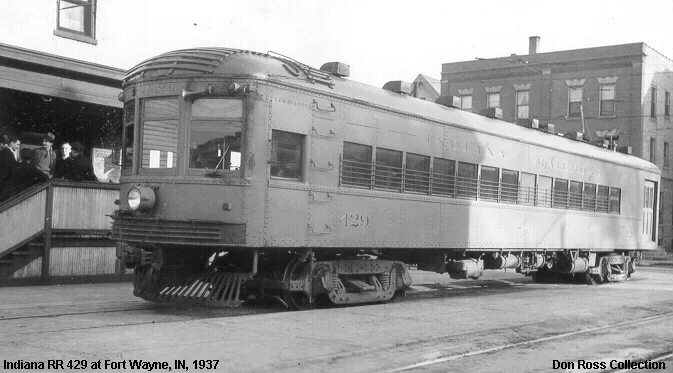Photo Credit: Don Ross Collection - Union Traction, then Indiana Railroad, No. 429 in "One Man" design at Fort Wayne, IN in 1937
Progress – with technological innovation comes an end to the predecessor industry as it scrambles to survive – Indiana’s electric railway industry was no exception.
The Indiana Railroad was a large network of electric railways comprised of many different electric cars from Indiana Service Corp., Interstate, Union Traction, Terre Haute Indianapolis and Eastern, and the Indianapolis and Southeastern – all major electric railway companies in Indiana.
In 1935, Indiana Railroad, which was the dominating interurban (high-speed electric train car between cities) route resulting from the acquisition of nearly every interurban line in Central Indiana, was looking for ways to cut costs and standardize equipment. Competition from the automobile and buses were injuring the interurban line’s finances, as the personalization and ease of these modes of transportation had great appeal.
A plan was orchestrated by the mechanical staff at Indiana Railroad’s Andersons shops in order to make the cars standardized and thus would reduce the crew required to operate each car from two to one. This ultimately would make variable staff costs as lean as possible.
The “one man” program was enacted in 1935 and 1936 on all cars that were to be retained and operated on the Indiana Railroad in its last effort to cut expenses.
The program was simple.
The rear of the car, as built, had steps on both sides for passengers to board. One of the steps was eliminated and the stairwell was enclosed with steel. The motorman’s (driver of an electric car) controller was moved into this space, which made the rear of the car the new front. When passengers came up the one set of remaining steps, they were greeted by the motorman who collected their fare on top of operating the car. This system eliminated the need for a conductor to collect fares and punch tickets, thus saving Indiana Railroad the cost of paying a conductor.
Ultimately, these efforts were not enough to save the Indiana Railroad. Every year, the improving highway system and appeal of the automobile eroded more passenger traffic until the final Indiana Railroad car ran in 1941.
Hoosier Heartland’s Union Traction No. 429 and 437 are the only two known remaining examples of cars from the Union Traction Company within Indiana. Both No. 429 and 437 went through the “one man” program. Preservationists previously reverted No. 429 back to its original design and floorplan during the 1970s. No. 437 remains in its altered design.
Our organization is proud and privileged to be the caretakers of these priceless artifacts from the Indiana electric railway industry. Hoosier Heartland’s goal is to have No. 429 operational for its 100th birthday in 2025 as part of our nonprofit mission. Our developing, long-term strategic plan strives to provide the only place in Indiana where one can experience, enjoy, and learn about the state’s world-renowned electric railway industry.

